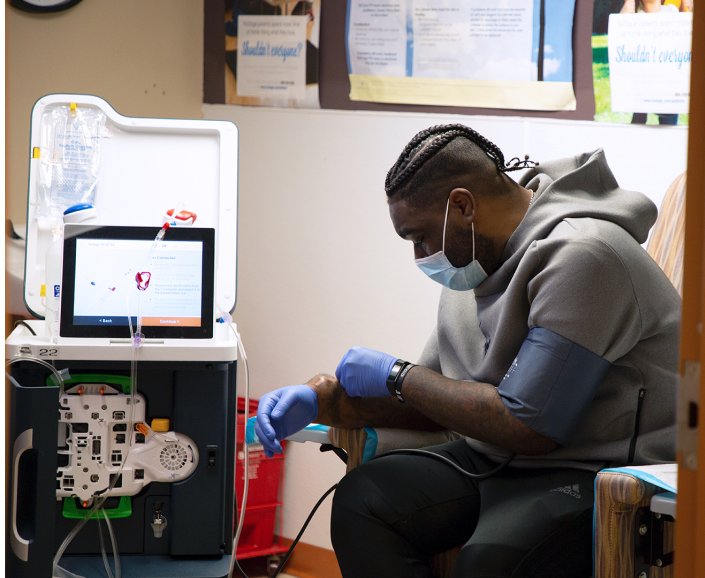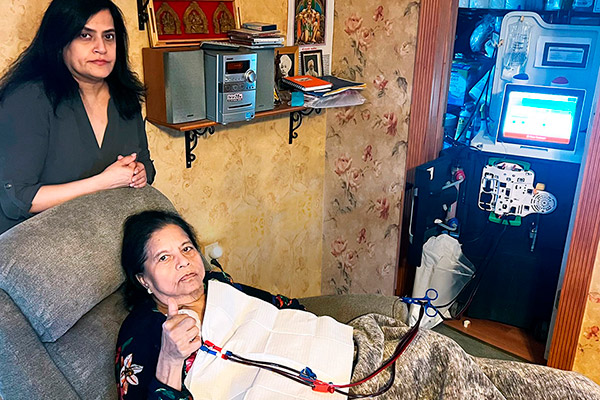6 Things Patients Considering Home Dialysis Should Know About Tablo
By: Michael Aragon, MD
Chief Medical Officer

“You need dialysis.” Words no person ever wants to hear. You have things to do, places to go, people to see. Not to mention, don’t people on dialysis feel terrible all the time? Thoughts quickly turn to memories of that family member, or friend, or family member of a friend who was on dialysis and always looked tired and sick.
As a practicing nephrologist for over 15 years, I have often helped my patients and their families work through these thoughts and internal dialogues. Every patient has a unique story when it comes to the diagnosis of their kidney disease. Some patients and their doctors work together for years through CKD stages trying to preserve kidney function and manage symptoms of kidney failure before dialysis becomes necessary; others “crash” into their diagnosis and then have to confront this reality for the first time from a hospital bed. Whether it’s been discussed over time or it’s all new information, the thoughts, feelings, and possibly images that the word “dialysis” brings to the forefront can be unpleasant and often depressing. There is, however, a bright spot that you may not be aware of — and that is how different dialysis can be from what you may have heard or experienced before.
While kidney transplant is the ideal treatment option, the reality is that there are just not enough donors to treat more than 100,000 new patients who are diagnosed with End-Stage Kidney Disease (ESKD) every year. This has, unfortunately, resulted in long wait lists. Dialysis can be the best treatment option while you wait, or long term, if transplant is not the right treatment choice for you. When faced with the need for dialysis, I strongly encourage you to talk to your doctor and ask about your home dialysis options, specifically home hemodialysis with the Tablo System. This may be a solution for you to live a full life with dialysis, rather than a life controlled by your dialysis. You can do it. And there are some significant ways that Tablo makes it easier!
1. Tablo helps you regain control over your dialysis and over your life
When your kidneys are failing and you need dialysis, it can feel like you’ve lost control of your own life. All of a sudden, life revolves around the times you’re assigned for thrice weekly in-center dialysis, where your 3 to 4-hour treatments are entirely managed by someone else. Or you’re doing at-home dialysis, likely peritoneal dialysis, every day or night, and living with dialysis fluid in your abdomen at all times or treating 5-6 times per week and timing your treatments around premade batches and limited volumes of dialysate. It’s hard, and it restricts the freedom you’re accustomed to as a person, which can be demoralizing.
Again, I want to emphasize: It doesn’t have to be that way. You can take back control of your life, live longer, and feel better by owning your own care at home with Tablo*. Instead of fixed chair times, you have the option to dialyze on your time, with an at-home hemodialysis system designed for patients to use easily. Most patients can train to go home with Tablo in just two weeks, but you can take all the time that you need. And, once home with Tablo, you’re free from a lot of issues that home dialysis patients often have to deal with, like rooms full of boxes of supplies, and batching dialysate for hours prior to treatments.
2. With Tablo, you have real schedule flexibility
You didn’t choose to do dialysis at home so that you could spend more than 20 hours a week just preparing for treatments. The impact on your life isn’t just the hours you spend treating several days a week, it’s also all of the preparation that goes along with it. Other home hemodialysis systems require you to dialyze 5-6 times per week, make batches of dialysate in advance of treatment, spend 30-45 minutes in set up, and “snap and tap” lines and dialyzers to remove air. It can all be a challenge for even the most motivated of patients and can put a strain on the strongest patient/care partner relationships.
With Tablo, there is no batching of fluid. Dialysate is produced on-demand, prepared and ready when you are. Removing batching also means relief from having to prepare dialysate ahead of time or rushing home to get your treatment done before your batch expires. Dialyze when it fits into your day, with a machine that can be set up and ready for treatment in under 20 minutes. Enjoy less work and stress managing your home dialysis, and more dialysis-free time. Plus, with a wide range of treatment times, schedules and prescription flexibility, you and your physician have more options to fit Tablo into your schedule while making sure you get the dialysis treatment you need (potentially, in as little as 3 treatments per week).
Clinical trial survey results have shown that amongst patients treating at home on Tablo with experience dialyzing at home with a different technology, 85% reported a preference for Tablo over their previous device.
3. Tablo lets your home be a home
No one wants their home to look or feel like a clinic or hospital. Yet, that’s exactly what many home dialysis patients have to accept in order to do their treatments at home. Boxes of medical supplies overtaking rooms, and a mess of lines, wires, hanging fluid bags, and instruction binders filling your living room or bedroom.
With its compact, mobile design and 12-lb. push weight, Tablo functions like a “clinic-on-wheels” that you can move about your home. When you’re done with your treatment, you can close Tablo completely to limit it from view, or wheel your 35-inch tall, 19-inch wide dialysis machine into a closet or another room to put it away. And because Tablo makes its own dialysate, you can store a month’s worth of supplies in the space of a small closet.
4. With Tablo, it is safety first
One of the most important aspects of taking care of yourself on dialysis is safety, and Tablo was designed to help you stay safe and maintain aseptic technique. During machine setup, friendly, animated on-screen instructions prompt you to remember the essentials of infection control, like hand washing, wearing gloves, wearing a mask, and cleaning your access area.
With Tablo, fewer manual connections mean fewer opportunities for contamination to occur. Every time a sterile line is open and closed there is a potential risk for contamination. Setting up a Tablo treatment involves just 6 steps where the lines are opened — connecting to saline, draining your prime, and the venous and arterial connections to the patient and dialyzer. With the system’s automated rinseback, there aren’t any other connections, other than removing the needles. No reversing lines.
5. Tablo may help you feel better
A dialysis treatment can be taxing. Patients who receive standard, in-center dialysis commonly report symptoms such as fatigue, cramps, headache, nausea and insomnia. These symptoms can last from as little as an hour to as long as their next treatment and have been shown to affect not only physical, but also mental health. To date, many patients have reported feeling better after Tablo treatments compared to the same-length treatments on other devices. Time-to-Recovery, measured during a recent trial, demonstrated a median time of less than 2 hours, regardless of whether patients were doing dialysis at home or in-center. Faster recovery means more time with more energy, and less time suffering from the “dialysis hangover.”
For home use, there are also potential ‘feel better’ advantages to Tablo. Dialysate, customized to your prescription, is produced on-demand, via a fully integrated water purification system, as opposed to dialysate that is batched or shipped with other home devices, helps avoid the fluid getting “stale” or having other impurities diffuse into the water or dialysate while in storage. Accurate fluid removal means lower risk of coming off of therapy washed out from accidental excessive fluid removal or coming off above your target weight. In our clinical trial, 94% of treatments finished within 10% of the initially entered fluid goal. With Tablo, what you target is what you will remove!
Embedded sensor technology results in tight temperature regulation and helps patients from feeling cold during treatment. In a recent home clinical trial, 28 of 30 participants reported feeling cold during treatments prior to entering the trial and, over an 8-week period, only 12 reported the symptom while treating at home with Tablo. And for patients who are sensitive to lactate, Tablo makes bicarbonate-based home dialysis a reality again.
6. Tablo makes it easy for your care partner to be involved and confident
Being a care partner can be both rewarding and challenging. From learning how to use needles to cannulate the access to setting up traditionally complex dialysis devices, many care partners are forced to assume the role of a home nurse or care technician. In most cases, this entails weeks of training, taking a significant amount of time off work, and overcoming a steep learning curve. But not with Tablo.
Training with Tablo is measured in days, not weeks, because there are drastically fewer steps to learn. With our available remote learning tools, even the busiest care partners can quickly become confident in supporting their patient while minimizing time away from other responsibilities. In addition, Tablo was designed to empower home dialyzors to take charge of their own treatments. A recently published study on Tablo at home showed patients needed fewer than 4 sessions to learn Tablo and, with that, reported needing no assistance with any aspect of their treatment in over 60% of treatment weeks. This is compared to a learning process that typically takes 4 weeks or more, with 3-5 sessions per week, on other devices. Just imagine, in 1-2 weeks’ worth of training sessions, you could be managing your own treatments on Tablo.
Another aspect of treatment that brings everyone anxiety is alarms. On Tablo, alarm resolution is a user-friendly, guided process. When the machine alarms, on-screen instructions identify the issue and prompt you both visually and verbally on how to resolve it. In our home study, the median time to resolve alarms was less than 5 seconds. Care partners can feel confident in their patient’s ability to care for themselves, so they can serve as a support for their patient, as opposed to being their dialysis technician.
Outside of infection control and quickly troubleshooting alerts, Tablo helps avoid treatment complications and frustrations that can come from having to set up more than once for a treatment. Via video-guided instructions, patients have an on-screen reminder every step of the way and a video guide for alerts. No memorization and full alarm guidance on the screen allows you to spend less time on pause dealing with alarms and more time progressing through your treatment safely.
With all of the above in mind, the reality is that a full life is possible with dialysis — rather than your life being controlled by your dialysis.
Results may vary. Please consult your physician for a complete list of indications, warnings, precautions, adverse events, clinical results, and other important medical information.

